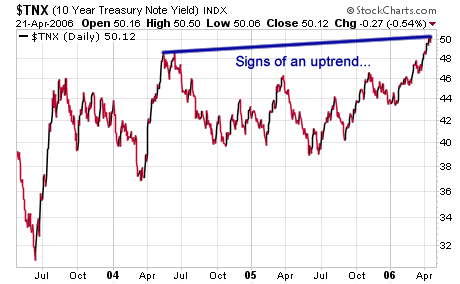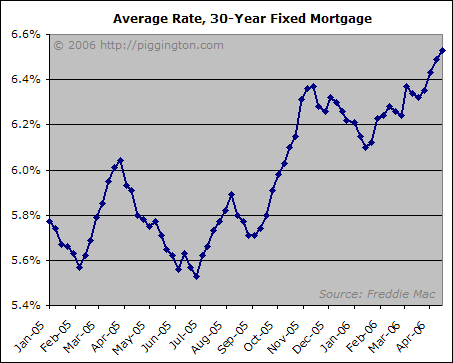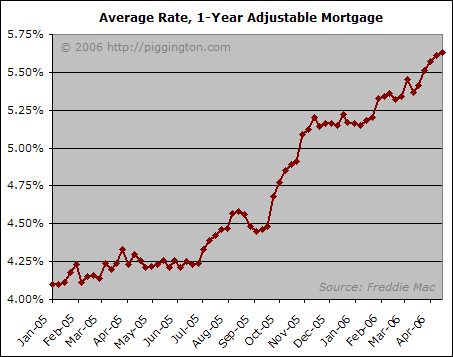It’s been an exciting month in the credit markets—that is, if you are the type of person who considers anything that happens in the credit markets "exciting." Sadly, I am just such a person, so without further ado let’s have a look at everything that’s happened since last month’s report.
The big news was that the yield on the all-important 10-year Treasury Note surpassed 5%. Why is this big news, and why is the 10-year "all important?"
Let’s start with the second question first. Even though fixed-rate mortgages are set for 30 or 15 years, their rates are compared to 10-year bonds (and mortgages are often securitized as such) because the average homeowner sticks with a given mortgage for about 10 years. As a result, trends in the 10-year Treasury interest rate will almost certainly also show up in fixed mortgage rates.
The answer to question 1 is that the move above 5% is very significant from a long-term trend perspective.
The last time the 10-year yield was this low was in 2002. Thereafter, yields on the 10-year started sinking until they were at a generational (and bubble-inflating) low of just above 3% in mid-2003. Many people think that mid-2003 low will end up having been the absolute bottom for the long-term bull market in bonds that began in the early 80s. But after shooting up to the almost 4.9% in early 2004, the 10-year rate started meandering downwards again and showed no signs of being in an upward trend. That is, until now:

The yield has now surpassed its 2004 high and bond bears, having gotten confirmation of their uptrend, seem to have the upper hand for the time being.
From a fundamental perspective, as I’ve discussed elsewhere on the site, there are some pretty good reasons to expect higher long-term interest rates at some point. America’s tremendous foreign indebtedness, the precarious future of the dollar, and rising asset and commodity prices all portend of higher rates to come. The problem is that these factors are nothing new. There has been good reason to expect higher rates for quite a while now, and yet higher rates were not forthcoming. Are the imbalances finally starting to matter, and if so, why now?
It may be that the Bank of Japan’s attempts to remove excess liquidity, which I discussed in last month’s report, are the immediate cause of the declining demand for US bonds. If so, that means there is more to come, because the BOJ has a lot of liquidity to mop up—and they haven’t even started hiking rates yet. For those interested in some numbers behind this idea, a recent Asia Times article about the BOJ’s tightening made the case that "[t]he fountain of liquidity that supported stellar stock- and bond-market performances in many countries in 2005 will soon be shut off."
If an uptrend is finally getting underway for 10-year bond rates, then we can expect fixed mortgage rates to rise right alongside them:

While long-term rates are important to both housing and economic activity, adjustable-rate mortgages are quite a bit more common than their fixed-rate brethren here in San Diego. But ARM rates continue to head up as well:

While the rise in ARM rates seems positively unstoppable, there may be a respite soon. Various Fed members are starting to eminate dovish cooing noises, implying that rate hikes are near an end. It’s unknown whether this is true. On the one hand, leading indicators (including housing activity) imply that the economy is starting to slow, and the Fed maintains that inflation is "contained." On the other hand, commodities and precious metals prices are through the roof, the stock market is making new highs, the CPI is being pressured upwards by energy prices, and there is still a lot of speculative activity in the real estate and mortgage lending areas. The fact is that nobody really knows what the Fed is up to, and for all their much-lauded transparency, the Fed-members just aren’t that up front about things (see the article about Robert Poole’s half-hearted attempt at housing boosterism for more on this).
For what it’s worth, the market seems to expect "one and done." But we’ve heard that before. My gut feeling is that the Fed will pause soon, if for no other reason than the incredibly cheerful rhetoric they spout simply doesn’t jibe with too many more rate increases. At some point, people will ask, "If inflation is contained, and the rampant price increases in housing aren’t symptomatic of a bubble, and the firmly-entrenched rise in oil and commodity prices aren’t carrying through to inflation, and skyrocketing precious metals prices are meaningless, then why do you just keep on raising rates?" The Fed will be faced with a choice: pause, or lose credibility. They will of course choose to protect their credibility.
Of course, an end to the Fed hikes might stop pushing upwards on mortgage rates, but those rates won’t experience any downward pressure from the Fed until the Fed actually starts cutting, which is likely a ways off.
So whether the Fed pauses are not, we are left with both fixed and adjustable rates being substantially higher—and buyer purchasing power accordingly lower—than they were a year ago.
Meanwhile, every little tick up on the above charts makes the spring/summer rally seem like a more distant dream. But we will be able to look at that topic in more depth next week when I get the latest batch of data…
